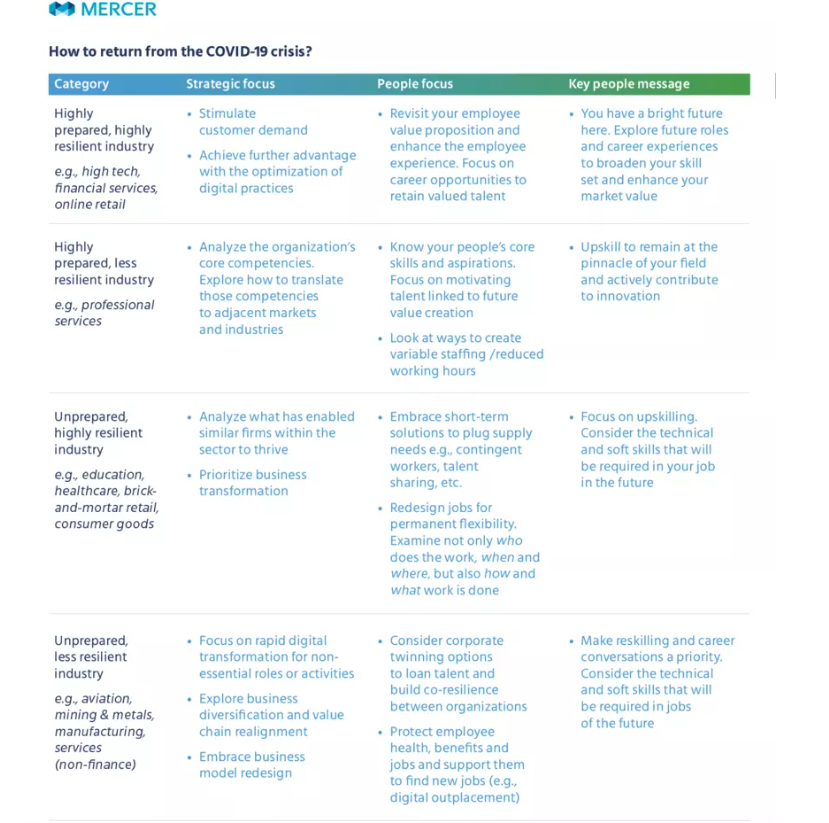by Kate Bravery and Avantika Tomar*
• Even prior to COVID-19, companies were envisaging the future as a survival struggle.
• Hard-to-digitize and people-dependent sectors are the least resilient.
• The crisis is an opportunity for companies and employees to reinvent themselves.
Survivalists know the importance of two key traits: preparedness and resilience. And so it is with companies. It is clear, for example, that early adopters of digitally enabled working are in better shape than others to face the challenges imposed by the coronavirus. Pre-outbreak, Amazon had invested heavily in HR technology for new hires, allowing the company to onboard 1,700 new employees on a single day recently. Resilience-wise, the concept of kurzarbeit, or reduced working hours, has new followers. In 2008, Germany’s manufacturers used the downtime to retrain workers and retool. The approach is credited with helping German industry to bounce back quickly after the financial crisis while others lagged.
Even before the current uncertainty, organizations’ plans for a downturn signaled that they were turning future-of-work strategies into survival tactics. In the event of unfavourable macroeconomic conditions, companies said they planned to increase strategic partnerships (40%), use more variable talent pools (39%), and invest in automation (34%), according to Mercer’s 2020 Global Talent Trends Study.
Though the present crisis has intensified the survivalist mood, with the spotlight on furloughs, retrenchment and public health, harnessed well the pandemic can spur a welcome rupture with business as usual. By diving into data on companies’ plans for 2020, together with what organizations are doing right now, we can glean insights into which businesses are best placed to survive, and which skills will allow for reinvention post-COVID-19.
Darwinian rules
An enterprise’s fortunes during the COVID-19 crisis rest significantly on its own preparedness and industry resilience. Take preparedness first, which in our view has three elements. The first is the extent of a company’s digital working practices going into the pandemic. On that score, the Talent Trends study shows that progress on the digital experience has stalled in recent years: Only two in five companies say they are mostly or fully digital, a figure that has not budged since 2018. This matters because digitization transforms how organizations leverage talent – helping them build diverse workforces, improve teaming, analyze performance and, vitally in today’s context, embrace flexible working.
Flexible working is another crucial component and, again, progress has been slow. Just 44% of companies say they systematically assess jobs for their adaptability – in other words, making flexibility dependent on the job, rather than a person’s circumstances. Only 22% of companies were ready for mass remote working prior to the outbreak, according to our pulse survey. Yet 37% of firms have implemented mandatory, company-wide work-from-home arrangements, and a further 17% have done so for specific departments. Remote working requires trust as well as digital infrastructure – trust in people’s reliability, capability and motivation. In this respect, COVID-19 is swiftly stripping the paper from the cracks. Two in five companies in the Talent Trends study say more trust is required between the organization and its employees to make flexible working work, and in the current climate 81% of companies worry about virtual working’s impact on productivity.
Agility in response to external shocks or stimulus is the third pillar of preparedness. Interestingly, when asked about “being more agile”, having fluid teams and workers with broad skill sets were most important to companies – above agile work practices, or agile organization design. Reskilling and an adaptable mindset are often the practical lens through which we can get a read on agility, but of concern is that although 78% of employees say they are ready to reskill, executives believe only 45% of their current workforce can adapt. Removing this mental block is vital to weathering the current, and future, storms – but with investing in future learning only #4 on HR’s priority list, it requires much more attention.
Resilience, meanwhile, largely depends on the type of industry concerned. According to our COVID-19 survey, the sectors experiencing significant impact from shutdowns are healthcare (56%), retail (56%), mining (55%), manufacturing (46%) and automotive (43%). Clearly, business models that are hard to digitize, highly people-dependent, or that rely heavily on global supply chains are most exposed. Conversely, the least affected sectors are professional services (4%), high tech (5%), education (9%), insurance (10%), and telecommunications (12%). Yet, depending on how long the situation continues, many of these will also feel the effects of limited funding for discretionary projects and value-adding services.
Reinvent your way out of the pandemic
Levels of preparedness and resilience will determine a given organization’s path out of the crisis and its workforce implications. Smart firms are keeping an eye on ways to return – at least to a new normal – from COVID-19, as well as opportunities for deeper restructuring to reinvent the enterprise. With respect to reinvention, many also acknowledge that the yardstick for success needs to change for a more responsible future. Today, companies broadly fall into four categories based on preparedness and resilience (see below).

A broader skills universe
The pandemic highlights how a vital part of future resilience will be the brokering of talent – that is, taking a broader view of where skills reside. Less resilient sectors could protect workers by loaning employees to highly resilient industries (who pay their salaries) for a limited period, with high-level contracts to stop the poaching of staff, for example. In the current crisis, marriages of convenience have sprung up, such as airlines in the UK offering grounded cabin crew as additional staff to temporary hospitals, or Hilton helping its workers apply for temporary jobs at e-commerce companies. In the future, such strategic partnerships will become more intentional and agreements to broker talent a hallmark of responsible employers.
The view of what skills are required is changing, too. The Talent Trends data reveal that, even before the crisis, employees and HR differed over what skills are and will be relevant. Innovation topped employees’ list of hot skills for 2020 and 2025. But innovation didn’t make HR’s list for either time horizon; rather, HR today prioritizes technical skills such as digital marketing and data visualization. Employees may be undervaluing some of the skills necessary for the long term, such as being agile, deploying design thinking or being entrepreneurial (the skills HR believes will be most in demand in five years).
Among sectors, automotive, healthcare and retail companies ranked innovation as a top three hot skill for 2020, perhaps in recognition it is sorely needed today (resilient sectors like technology and insurance are focused on hard skills, such as data science and predictive modeling). But, looking to 2025, we see both highly and less resilient industries rank agile transformation among the top two skills required of workers. Undoubtedly, agility will dominate discussions this year as companies take steps to simultaneously rebound and drive reinvention.
Maintaining the momentum
COVID-19 is a catalyst for change – and it’s a change employees are thirsty for. Trapped by low productivity and declining margins, many business models struggled to create space for innovation leaving employees frustrated. Organizations’ response to the pandemic has birthed unprecedented cross-industry collaboration. Who would have imagined that people would transform diving masks into ventilators, or technology titans would pool computing power in the search for therapies? With employee morale lifted by outpourings of empathy and action to address this crisis, what other customer or societal challenges can we start tackling now via a communal creative process?
Digital skills, design thinking, entrepreneurship, and innovation will all be crucial skills post-pandemic. The challenge will be to sustain the hastily constructed structural and cultural infrastructure that fosters true ingenuity. Maintaining the momentum for change that COVID-19 has brought, unwittingly, to the table is a chance to focus on the skills that enable us to build back better.
*Partner and Head of Advisory Solutions & Insights, Mercer and Principal and Global Solutions Lead, Workforce for the Future, Mercer
**first published in: www.weforum.org




 By: N. Peter Kramer
By: N. Peter Kramer
